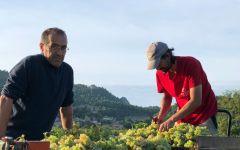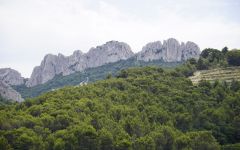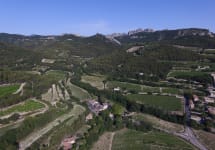Chateau de Saint Cosme Saint-Joseph 2019
-
Wine &
Spirits -
Jeb
Dunnuck -
Wine
Spectator -
Robert
Parker



Product Details
Your Rating
Somm Note
Winemaker Notes
Louis Barruol describes the microclimate of the vineyard Malleval as “very cold” which allows the grapes to retain acidity and showcase the floral aromas of the local Sérine variety. Aromas and flavors of blackberries and wild strawberries are accented by notes of peppercorns, tobacco, peonies, and violets.
Syrah, with its deep flavors and firm tannins, is a natural match for grilled or smoked meat and dishes featuring herbs, roasted mushrooms, and onions. Seared venison or beef with black pepper and thyme or a Moroccan tagine of pigeon or chicken are complimented by the spicy characteristic of Syrah.
Professional Ratings
-
Wine & Spirits
This is bright and invigorating, with a bone-warming radiance. It’s made from an old clone of syrah, sourced from parcels in Malleval, at the northern end of St-Joseph, and captures the coolness of the area in the fresh crunch of its fruit and the its effusive florals. Underneath, darker notes of damp earth and stone give the wine a fullness and firmness that bodes well for this wine’s future, though it’s hard to resist at the moment.
Best Buy -
Jeb Dunnuck
The 2019 Saint Joseph has a Côte Rôtie-like vibe and offers beautiful black raspberry fruits as well as subtle bacon fat, flowers, and spice. It’s elegant and medium-bodied, with terrific ripeness and outstanding length on the finish. It’s a classy Saint Joseph to drink over the coming 10-12 years. Best after 2022.
-
Wine Spectator
Very stylish, with perfumed red and black cherry coulis notes infused with dried rose petal, sanguine, sandalwood and white pepper. Silky and fresh through the finish, with lingering minerality. A wine of nuance.
-
Robert Parker's Wine Advocate
Saint Cosme's 2019 Saint Joseph features alluring scents of baking spices, roasted meat, black cherries and black olives—it's a lovely, aromatic offering. In the mouth, it's medium to full-bodied, silky and fine, with those ripe tannins and balanced acids imparting a sense of freshness and vitality that persists through the elegant finish. Sourced from granite terroirs at the northern end of the appellation, it's easily the equal of some producers' Côte Rôties.
Other Vintages
2021-
James
Suckling
-
Wine
Enthusiast -
Wine
Spectator - Vinous
-
Jeb
Dunnuck -
Robert
Parker
-
Wine
Spectator -
Wine
Enthusiast -
Jeb
Dunnuck
-
James
Suckling -
Wine
Enthusiast -
Jeb
Dunnuck -
Wine
Spectator -
Robert
Parker
-
James
Suckling -
Robert
Parker -
Jeb
Dunnuck
-
Robert
Parker -
Wine &
Spirits -
James
Suckling
-
Wine
Spectator
-
Wine
Spectator -
Robert
Parker
-
Wine
Spectator
-
Robert
Parker -
Wine
Spectator
-
Wine
Spectator -
Robert
Parker
-
Wine
Spectator
-
Robert
Parker
-
Wine
Spectator
-
Wine
Spectator -
Robert
Parker
-
Wine &
Spirits -
Wine
Enthusiast
-
Robert
Parker
-
Robert
Parker







Chateau de Saint Cosme is the leading estate of Gigondas and produces the appellation’s benchmark wines. Wine has been produced on the site of Saint Cosme since Roman times, evident by the ancient Gallo-Roman vats carved into the limestone below the chateau. The property has been in the hands of Louis Barruol’s family since 1570. Henri and Claude Barruol took over in 1957 and gradually moved Saint Cosme away from the bulk wine business. Henri was one of the first in the region to work organically beginning in the 1970s. Louis Barruol took over from his father in 1992, making a dramatic shift to quality, adding a négociant arm to the business in 1997, and converting to biodynamics in 2010.

Marked by an unmistakable deep purple hue and savory aromatics, Syrah makes an intense, powerful and often age-worthy red. Native to the Northern Rhône, Syrah achieves its maximum potential in the steep village of Hermitage and plays an important component in the Red Rhône Blends of the south, adding color and structure to Grenache and Mourvèdre. Syrah is the most widely planted grape of Australia and is important in California and Washington. Sommelier Secret—Such a synergy these three create together, the Grenache, Syrah, Mourvedre trio often takes on the shorthand term, “GSM.”

Spanning the longest stretch of river in the northern Rhône—from Condrieu in the north, to Cornas in the south—the heart of St.-Joseph lies directly across the Rhône River from Hermitage. While its soils are basically the same as Hermitage: granite, supplemented by sand and gravel, its east facing slope receives less sunlight than Hermitage, which causes less overall berry ripening on its Syrah vines. However, some of the best of them can rival any fine expression of Hermitage, Cote-Rotie or Cornas with concentrated black fruits, dark spices, crushed rock and violets. A general advantage of the region is that its Syrahs typically don’t need as much time in the bottle compared to a Cote-Rotie or Hermitage and are much easier on the bank account!
A textbook St.-Joseph red is firm with a core of minerality that is enhanced by savory and peppery qualities. Aromas and flavors of smoke, olives, herbs, and violets are common; its wines are dense in red and black fruit.
St.-Joseph is also a source of fine northern Rhône white wine. Viognier, Marsanne and Roussanne grow well here and can be blended or made into single varietal wines. St.-Joseph whites are full and silky with citrus, pear and pineapple flavors and a rich bouquet reminiscent of honeysuckle, toasted nuts, spice and caramel.
